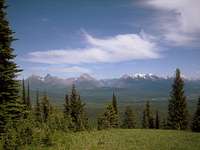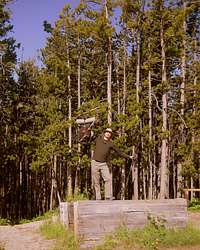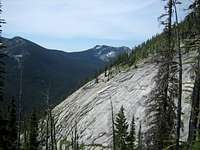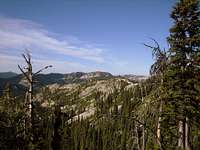|
|
Custom Object |
|---|---|
|
|
48.99607°N / 113.65979°W |
|
|
Long Distance Hiking Trail |
Pacific Northwest Trail Summit Post Page
The Pacific Northwest trail is an 1,100+ mile trail with roots dating back to the 1970s. It is a work in progress, ever-changing and evolving. The description here-in is also a work in progress. It contains only a fraction of the information necessary to hike a trail of this magnitude in its entirety but will provide more than enough information for a potential hiker to use as a jumping off point.If you think there is important information to add to this page don't hesitate to suggest it. To make suggestions or recommendations please contact the author directly and your suggestions will given full consideration.
About the Pacific Northwest Trail
The 1,136 mile Pacific Northwest Trail (PNT), running from the Continental Divide to the Pacific Ocean, ranks among the most scenic trails in the world. This carefully chosen path is high for the views and long on adventure. It includes the Rocky Mountains, Selkirk Mountains, Pasayten Wilderness, North Cascades, Olympic Mountains, and Wilderness Coast. The trail crosses three National Parks and seven National Forests.History of the Pacific Northwest Trail
Long-distance trails are as old as the seasonal migrations of herders and their livestock. Emigrant routes, such as the Oregon Trail, populated America's vast West. But long-distance recreational trails are a distinctly twentieth-century phenomenon. Vermont's Long Trail dates from 1910, the Appalachian Trail from 1921.Thirty years ago the Pacific Northwest Trail was born from the traditions of those earlier trails when Ron Strickland began to seek a way west from the Continental Divide to the Pacific Ocean.
In the late sixties the backcountry experienced an explosion of recreational walking for pleasure. The federal government's changing backcountry management priorities and the new backcountry recreation movement met head on. The result was increased pressure on the relatively few popular trails maintained for outdoor recreation. Maintenance budgets have declined so precipitously that hikers often need Sherlock Holmes' skills to follow some of the old trails.
The bedrock Pacific Northwest Trail philosophy is that local volunteers are the key to development and maintenance. Only they have the grass roots contacts and knowledge to do the job right. Take Max Eckenburg, for example. His grandfather was a timber cruiser in Whatcom County where Max himself was successful decades later in designing our Chuckanut section. In the mid-1980's, Max married Carol Hull, another of our volunteers. They built a homestead on Pontiac Ridge near Mount Bonaparte where Max continued to develop our northeast Okanogan County route. This personal dimension is the essence of the PNT experience.
Map of the Pacific Northwest Trail
Montana
The Pacific Northwest Trail begins its westerly trek at the Chief Mountain Ranger Station entrance to Glacier National Park. Hikers typically arrive via automobile off of Hwy 89 and can be deposited directly at the trail head for the Belly River trail.The walk across Glacier National Park is full of world class views on well-maintained and signed trails. The official route traverses Brown Pass, down to Bowman Lake and onward to the park entrance near the quaint hamlet of Polebridge, MT.
 Glacier National Park as viewed from the West across the valley of the North Fork of the Flathead River.
Glacier National Park as viewed from the West across the valley of the North Fork of the Flathead River.Idaho
The crossing of the Montana Idaho border is a melodramatic one. No signs are posted to mark what can be a glorious moment for a thru-hiker just having walked the hundred some odd miles from the trail's start.Kaniksu National Forest, the Kootenai River and the Salmo Priest Wilderness are the treasures witnessed in the fifty or so miles spent walking across Idaho's pan handle. It is in this state that the hiker enters another mountain range, the Selkirks.
The wilderness of Idaho's panhandle sees little human traffic aside from the hunting population in the fall. A handful of hot spots for backpacking do exist outside of Bonner's Ferry with trips to areas such as the Ball Lakes attracting crowds of hikers in the heat of the summer.
A highlight of the Pacific Northwest Trail in its current state of relative infancy are some of the trail-less bushwhack sections. One of these is located near Lower Ball Lake as the route traverses into and down the Lion Creek drainage.
Washington
The hiker enters Washington about as melodramatically as the crossing from Montana to Idaho but once again the scenery is gorgeous and often solitude saves the moment for that hiker and that hiker alone. The Salmo Priest Wilderness is small but provides for some very raw alpine-like scenery.The hiker finds themselves walking the arid desert like country of Northeastern Washington through mountains, hills and river valleys. Along the way they will pass through the well-irrigated Columbia River valley, the spectacular Kettle Crest Trail, the orchard-rich Okanogan River valley and then into one of the penultimate PNT wonders - the Pasayten Wilderness.
The Pasayten is one hundred twenty-five miles of roadless wilderness criss-crossed with the nicely manicured trails of the USFS. The Boundary Trail #533 provides spectacular walking at extended distances over 7,000 feet elevation interspersed by dips down into lush river valleys.
In keeping with the wilderness theme, the Pacific Northwest Trail crosses the Ross Lake Resevoir and then immediately climbs into the Cascade Mountains including North Cascade National Park and the Mount Baker Wilderness Area.
Once out of the hundreds and hundreds of miles of wilderness the trail begins to weave its way in and out of civilization, passing mere miles from the thriving urban center of Bellingham. A quick ferry ride across Puget sound followed by a few more jautns through towns and the hiker once again finds themselves in the heart of the wilderness - this time in the Olympic Mountain Range.
Up and over the Olypics goes the hiker eventually reaching the expansive Pacific Ocean which they have been striving for for over 1,000 miles. The joyous hiker dips their toes in the waves of the Pacific and then slowly savors the last few dozen miles of walking along the beach before completing the Pacific Northwest Trail at Cape Alava on the Western-most point of land in the lower 48 states.
Permits and Red Tape
The vast majority of the Pacific Northwest Trail requires no special planning in terms of regulated, permitted camping. Nights spent on (non-wilderness) National Forest land require no permits and only LNT needs be practiced. Consideration to permits and permission needs attention in the National Parks (Glacier, North Cascades and Olympic) as well as the Pasayten Wilderness and private camping areas (although these can be avoided with some forethought).Glacier National Park - backcountry information North Cascades National Park - backcountry permit information Olympic National Park - wilderness trip planner
Guidebooks and Maps
There is one official guide book to the Pacific Northwest Trail. It was researched and written by Ron Strickland one of the visionaries and original thru-hikers who first conquered the PNT route. His guidebook is entitled Pacific Northwest Trail Guide: The Official Guidebook for Long Distance and Day Hikers.Paperback: 320 pages
Publisher: Sasquatch Books (March 1, 2001)
Language: English
ISBN-10: 1570611777
ISBN-13: 978-1570611773
The official guidebook contains versions of the USFS 7.5 minute quandrangle maps depicting the trail in a bold line. Supplemental maps to consider would be USFS road maps of the area surrounding the trail, hiking maps of the various wilderness areas and National Parks or specialized area maps. These can act as supplements to the route or provide information about lands adjacent to the trail in case an alternate route needs to be considered.








